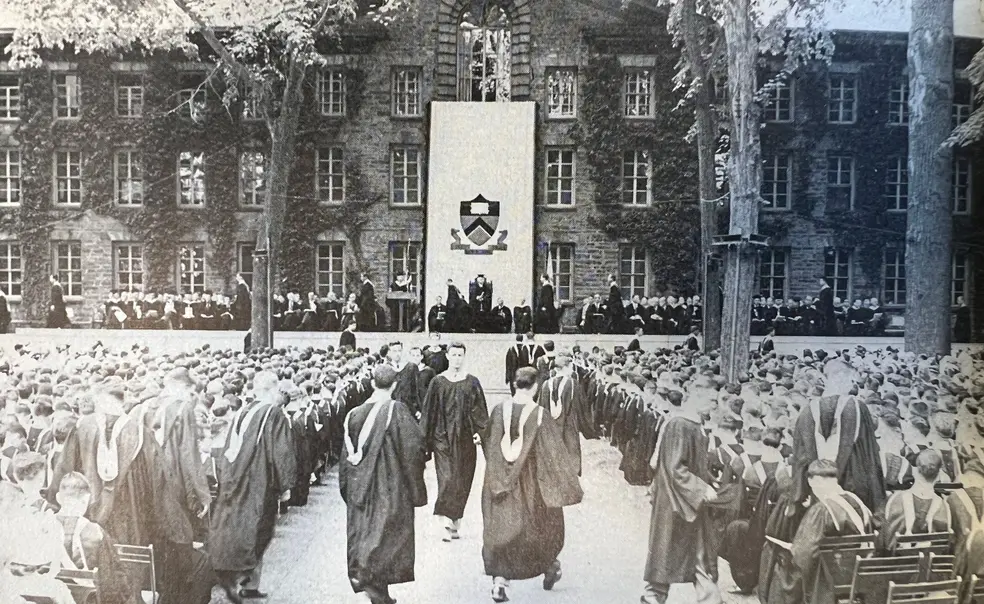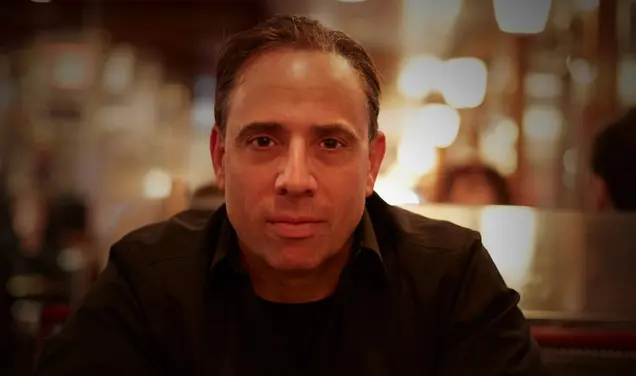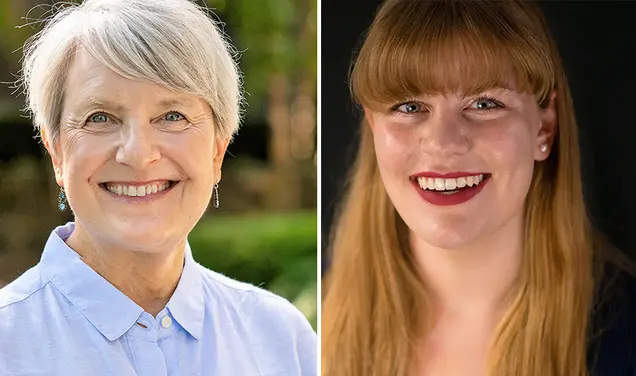Rally ’Round the Cannon: A New Kind of Class Arises from the Ashes
“How long since you been home?”
“Oh, a coupla centuries.”
— Al Stephenson, The Best Years of Our Lives, 1946
It’s been three years now since we bid our ancestors of the Greatest Generation — I’ve always detested Tom Brokaw for coming up with that term, and if possible I now even detest him more because it appears in further retrospect to be true — a melancholy farewell in 1946-47 as they returned from World War II to a faint semblance of their former lives. Your homework assignment for our precept is to see William Wyler’s cinema masterpiece The Best Years of Our Lives, even if it’s for the fourth time, and realize that the personal disorientation it depicts among those returning from war operated on a societal level as well, impacting essentially everything around it and changing the course of everything that followed.
What followed is where we pick up the thread today. At Princeton, the War Generation had its last hurrah at the mammoth year-long blowout for the University’s Bicentennial, preceded by the June 1946 Victory Reunion comprising a then-unimaginable 7,300 alumni laying waste to the Mercer County countryside. Ever wonder how everyone (or anyone, actually) survived that grand debauch and made it to the end of the P-rade? You should suspect without even pausing that the answer lies precisely where the logistic success of Reunions lies yet today — the phalanx of manic undergrad worker bees who run the hundreds of small class events successfully because they’re too naïve to know it can’t be done. Meet the Class of 1949.
The first piece of the class appeared in June 1945, while the war in the Pacific was still raging. The 325 matriculants instantly tripled the number of civilian students on campus; everyone else was still training for one of the services or another. This was in line with a new trimester plan the faculty decided to try out, to enable more prospective students to study at Princeton, accelerating some, spreading others out while the classrooms perked along at breakneck speed 24/7. Before the war, the largest civilian student population had been about 2,400. By the time the second and third components showed up in October and March, the Class of 1949 numbered 759 members. By the time they left, there were almost 3,400 students overall, as more civilians (old and new, old and young) poured onto campus, some with military decorations, some with wives and/or offspring, some straight from high school, the wild mix turned to a combination of accelerated studies. The faculty, about a third newly returned as well, tried to make academic sense of this, keeping in mind a Princeton degree required two years residency on campus. Meanwhile, sometimes painful resuscitation of student activities began; The Daily Princetonian, whose first postwar issue went to press on Jan. 5, 1946; WPRU, whose closed-circuit newsflashes over the electrical system threatened campus phonographs again; Triangle, whose comeback production Clear the Track played to national notoriety on Dec. 13, 1946. In the spirit of the day, football, led by coach Charlie Caldwell 1925, went back to a representative Eastern schedule in 1946 with the “new” single wing offense, including a huge 17-14 win over nationally ranked Penn that led to riots in Philadelphia, with police horses tearing up the sacred Franklin Field turf. But what the class always remembered was the Victory Reunion, at which they served the returning war heroes and bonded the Princeton of the past with themselves, the Princeton of the future.
The new kids on the block were a diverse group, to be sure: There were many ways in which they only faintly resembled their forebears. Let’s look at some of the more interesting.
One of the elder contingent, and typical of many, was Brendan Byrne ’49. He graduated from West Orange High School in New Jersey in 1942, had a cup of coffee at nearby Seton Hall in South Orange, then signed up for the Army Air Forces. He flew as a B-17 navigator during the harrowing earliest days of the American bombing campaigns in Europe, and he was awarded the Distinguished Flying Cross and four Air Medals. Released early enough to apply to Princeton in 1945, he was a 21-year-old freshman. Knowing what he wanted academically, he studied in SPIA and graduated cum laude in 1949. But at that point he had already been at Harvard Law for a year, and he actually wrote his politics-tinged thesis on “Proportional Representation in Municipal Government” in Cambridge. He returned to practice law in East Orange (you knew that was coming, right?), then at 31 was appointed as assistant counsel to the New Jersey governor. A batch of state and county jobs, including prosecutor, led to a seat on the state Superior Court in 1970; three years later he resigned to run for governor himself. After a landslide win in 1973 and a close shave in 1977, the highly personable Byrne then was the last Democrat to be re-elected governor in New Jersey for 44 years. Afterward, he wrote a highly visible politics column with Tom Kean ’57, a Republican ex-governor, and taught at both Princeton and Rutgers. He died at 93, an honored elder statesman, in 2018.
Paul Volcker Jr. ’49 graduated from Teaneck High School in New Jersey (sensing a theme here?) in 1945, three years behind Byrne, and so missed the service. There his reputation as a political expert was rampant, and he went straight to Princeton, to SPIA as well, and clairvoyantly wrote his thesis on “The Problems of Federal Reserve Policy Since World War II,” graduating summa cum laude. At 6-foot-7-inches he stood out anyway, playing varsity basketball and getting grabbed for just about every other intramural sport that had been revived. After graduation he headed straight for the Fed in New York, doing grad work along the way at Harvard and the London School of Economics. He bounced back and forth between the Treasury Department and Chase Manhattan, then taught at Princeton before becoming president of the New York Fed in 1975, then chair of the whole shootin’ match in 1979. Along the way, he led the destruction of the gold standard (hard to even conceive today) and became politically controversial as the Fed put the brakes on inflation during the Reagan administration. After he left office in 1987, he essentially patrolled the world, bringing his economic expertise to bear on everything from repatriating Jewish assets stolen in Europe during the war to the International Accounting Standards Board to the United Nations Food for Peace Program to the Group of Thirty to his own Volcker Alliance to rebuild public trust in government. After the 2007 economic cataclysm, Barack Obama’s proposed bank reforms were dubbed “the Volcker Rule.” At his death at 92 in 2019, his stack of dozens of honorary degrees was almost as tall as he.
Jim Lebenthal ’49, was barely 17 when he came to Princeton in 1945, part of the young contingent from Andover. That and his parents owning their own investment bank in New York seemingly forced the admission office to overlook his Jewish heritage and admit him. Lively and personable, he was a huge media freak: photo editor for the Princetonian, news director for WPRU, and even a stringer for Life magazine. Being a politics major complemented this perfectly, and his thesis “The Nomination and Thomas E. Dewey” was essentially a “fresh off the presses” post mortem. He then worked in media and advertising for 14 years and was nominated for an Oscar at Disney. But that isn’t why everybody knew Jim Lebenthal. The municipal bond brokerage founded by his parents left his mother, Sayra, one of the most powerful women on Wall Street when his father, Louis, died in 1951. When she turned 65 in 1963, Jim joined her and gradually took on the brokerage. He then created a novel advertising image for the firm as the safe muni haven for the small investor, and his lively radio and TV ads made him a household name, eventually joined on the air by his own daughter, Alexandra ’86, beginning in 1988. At various points class agent, secretary, and president, he died at 86 in 2014. But not before his book Confessions of a Municipal Bond Salesman included a foreword by no less than classmate Volcker, admiring Jim’s muni-hawking smile “popping out of sewers, standing in front of the Verrazano Bridge as if he owned it.”
Which brings us to Jim Amick ’49. Four months older than Jim Lebenthal at 17, he came to Princeton in 1945 from Bound Brook High School (yep, New Jersey); his dad was a chemist with Cyanamid and it carried over. Pausing to manage the Chapel choir, Jim majored in chemistry and graduated cum laude one term early in February 1949. After a year at Brookhaven Lab, he returned to Princeton for a master’s in 1951, Ph.D. in 1952, and a year of postdoctoral work. His dissertation was on “Studies in Infrared Absorption.” Then he moved across Route 1 to RCA Labs, where he was part of a pioneering solid-state experimental group. In the 1970s he moved to Exxon, then on to Mobil, where he did extensive research on the first generation of solar cells. He lectured around the world on solid state and solar energy issues for years, and he holds 10 patents in the fields. He was a leader with the Electrochemical Society for 30 years, serving his last 10 as secretary, vice president, and then president from 1994-95. After his retirement, he was a board member of the Princeton Unit of Recording for the Blind and the Trenton After School Program.
And most important, on May 24, 2025, the 97-year-old Jim Amick ’49 *52 became the first alumnus of the 1940s and the second graduate alumnus ever to win the Class of 1923 Cane and lead the P-rade as the senior alum present. As a representative of Byrne, Volcker, Lebenthal, and the other 755 men who piled onto campus amid slightly controlled chaos throughout 1945, he’s now iconic as a symbol of postwar Princeton. Together, perhaps they show the Greatest Generation have legacies who were more than worthy in themselves.
Dei sub numine viget.











No responses yet